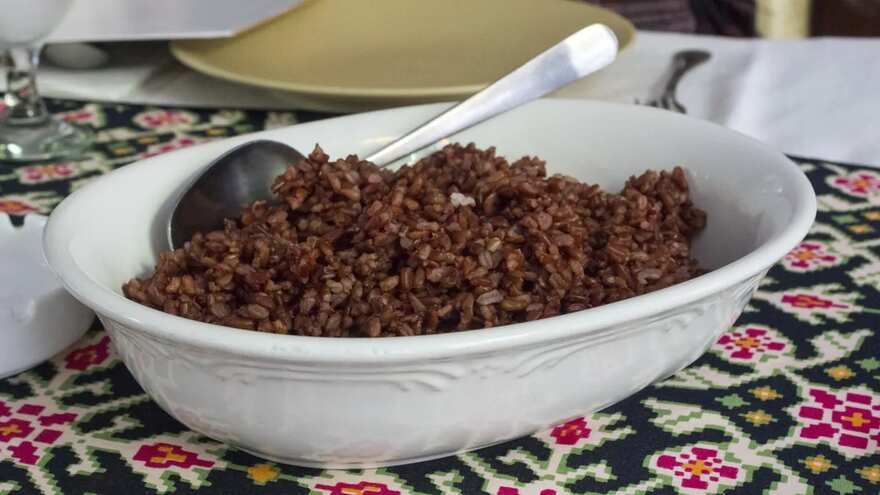Nestled amidst the breath-taking landscapes of the Himalayan region in India, the state of Himachal Pradesh is known for its pristine beauty, vibrant culture, and delectable cuisine. Among its culinary treasures, Himachali Red Rice stands out as a nutrient-rich staple that holds a special place in the hearts and plates of the local population.
In this article, we will delve into the remarkable flavour of Himachali Red Rice, exploring its origins, unique characteristics, health benefits, diverse culinary uses, and the cultural significance it holds in the region. Join us on a flavourful journey through the traditions and gastronomy of Himachal Pradesh.
The Origins and Cultural Significance of Himachali Red Rice: Himachali Red Rice, also known as Rakti Rice, traces its roots back to the fertile valleys and terraced fields of Himachal Pradesh. This indigenous rice variety has been cultivated for generations by the local farming communities, who have carefully preserved the traditional methods of cultivation and processing.
Himachali Red Rice not only serves as a dietary staple but also holds cultural significance, being an integral part of festive feasts, weddings, and other traditional rituals. It is often considered a symbol of abundance, prosperity, and community celebrations.
Unique Characteristics and Flavour Profile: One of the distinguishing features of Himachali Red Rice is its deep reddish-brown color, which sets it apart from other rice varieties. This hue is attributed to the presence of natural pigments called anthocyanins, which possess antioxidant properties.
The grains of Himachali Red Rice are slender and aromatic, with a slightly nutty flavour that adds a delightful complexity to dishes. The rice has a firm texture, allowing it to retain its shape and absorb flavours, making it a versatile ingredient in various culinary preparations.
Health Benefits of Himachali Red Rice: Beyond its exquisite flavour, Himachali Red Rice offers a range of health benefits. It is a rich source of dietary fibre, essential minerals such as iron and magnesium, and vitamins like vitamin B6. The high fibre content aids in digestion, promotes satiety, and helps maintain healthy cholesterol levels.
Additionally, the presence of antioxidants in the rice supports overall well-being and helps combat oxidative stress in the body. Himachali Red Rice is also gluten-free, making it a suitable choice for individuals with gluten sensitivities or dietary restrictions.
Culinary Uses and Preparations: Himachali Red Rice lends itself to a multitude of culinary creations, showcasing its versatility in both sweet and savoury dishes. It serves as the foundation for traditional Himachali delicacies such as Red Rice Pulao, where the grains are cooked with aromatic spices, local herbs, and seasonal vegetables.
The rice also pairs well with local lentil preparations like Madra, offering a hearty and wholesome meal. Its distinct flavour and texture make it an excellent choice for biryanis, pilafs, and risottos. In addition, Himachali Red Rice can be used in desserts such as Kheer (rice pudding), where its natural sweetness and unique texture elevate the dish.

Preservation of Traditional Farming Practices: The cultivation of Himachali Red Rice is not only about its flavour and nutritional value but also about the preservation of traditional farming practices and biodiversity. Many farmers in Himachal Pradesh continue to grow this heritage rice variety using sustainable agricultural methods, avoiding the use of harmful chemicals and pesticides.
The conservation of indigenous rice varieties like Himachali Red Rice helps maintain biodiversity, protect the environment, and support the livelihoods of local farming communities. It is an acknowledgment of the ecological and cultural importance of preserving traditional crops and farming techniques.
Promoting Himachali Red Rice as a Culinary Treasure: To promote the appreciation and consumption of Himachali Red Rice beyond the borders of Himachal Pradesh, efforts are being made to showcase its unique qualities in culinary events and festivals. Local chefs and food enthusiasts are experimenting with innovative recipes that highlight the rice's distinct flavour and texture.
The government and non-profit organizations are working together to create awareness about the nutritional benefits and cultural significance of Himachali Red Rice. Through these initiatives, Himachali Red Rice is gaining recognition as a gourmet ingredient and contributing to the preservation of the state's culinary heritage.
Conclusion: Himachali Red Rice stands as a testament to the rich cultural heritage and culinary excellence of Himachal Pradesh. Its exquisite flavour, unique characteristics, and health benefits make it a cherished staple in the region. The preservation and promotion of this indigenous rice variety not only support local farming communities but also contribute to the conservation of biodiversity and traditional agricultural practices.


